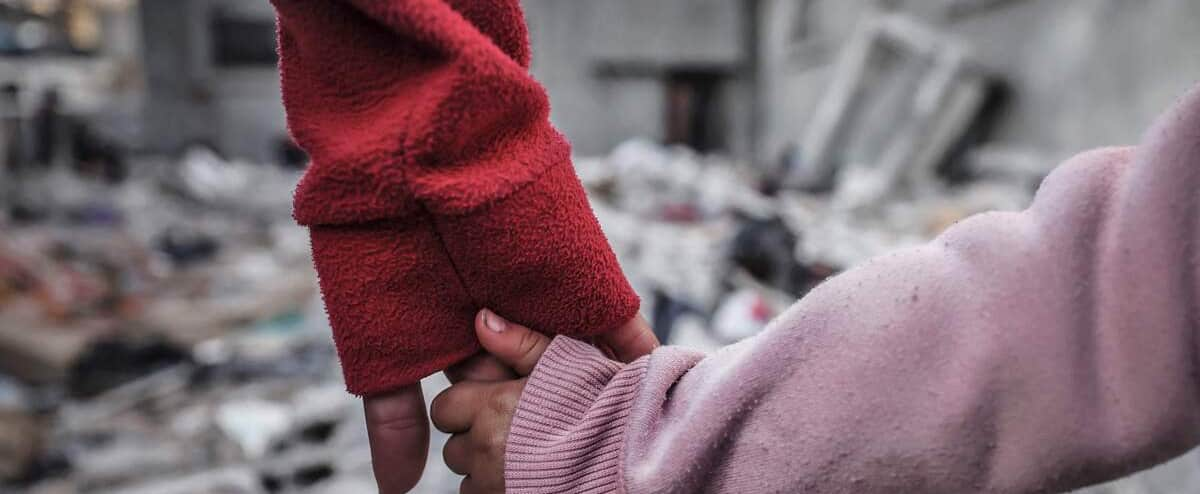Deadly strikes, fierce fighting, incessant displacement and dribs and drabs of humanitarian aid: “exhausted” by nearly three months of war, the population of Gaza dreams of the “end” of the clashes this New Year’s weekend.
• Read also: The war in Gaza would have left 21,507 dead, according to a new report
• Read also: Israeli strikes on Gaza, Hamas discusses ceasefire in Egypt
• Read also: Fear of an “expansion” of the conflict in Gaza
“People celebrate the coming of the new year, but we can’t. We are deprived (of celebrations). The bombs continue to fall on us every day and every night,” says Oum Louay Abou Khater, 49, displaced by the fighting in Rafah, at the southern tip of the Gaza Strip.
“I hope the war ends soon. Enough of this war! We are totally exhausted. We are constantly moved from one place to another in cold weather,” she adds in an improvised camp to accommodate displaced people.
AFP
“2023 was the worst year of my life. It was a year of destruction and devastation. We experienced a tragedy that even our grandparents did not know,” adds Ahmed al-Baz, 33.
“I hope that the war will end and that we will return to our homes and our normal daily life before 2024. We are not asking for anything more,” sighs this Palestinian, also displaced in Rafah by the clashes.
The approximately 2.4 million inhabitants of the Gaza Strip, 85% of whom have had to flee their homes according to the UN, continue to face a disastrous humanitarian situation.
“The traumatized” and “exhausted” population is piling up on “an increasingly small plot of land” in the south of the territory, in the Rafah sector, the head of operations declared on Friday on X (ex-Twitter). UN Humanitarian Affairs, Martin Griffiths.

AFP
“The quantity of aid delivered, necessary and urgent, continues to be limited and encounters numerous logistical obstacles,” denounced the commissioner general of the UN agency for Palestinian refugees (Unrwa), Philippe Lazzarini.
The International Court of Justice also announced on Friday that South Africa accused Israel before this United Nations judicial body of engaging in “acts of genocide against the Palestinian people in Gaza”, allegations immediately rejected “with disgust” by Israel.
From Gaza to Lebanon
On the 85th day of the war, triggered by an unprecedented Hamas attack on October 7 that left around 1,140 dead in Israel, mostly civilians, air raids and ground fighting show no sign of respite in the Gaza Strip. .
During the night, the Palestinian Islamist movement reported violent clashes in Khan Younes, the main city in southern Gaza, and in the center of this besieged territory, including deadly airstrikes in the Nuseirat sector.
According to the Hamas administration’s Health Ministry, 187 people were killed in the Gaza Strip on Friday, bringing the local death toll since the start of the war to more than 21,500.

AFP
Shortly after midnight on Saturday, the Israeli army announced strikes in Syria, in retaliation for rockets fired from this neighboring country which fell into border territories under its control.
The Israeli military rarely claims strikes in Syria, but has repeatedly said it will not allow its archenemy Iran to expand its presence there, including through militias or armed groups like Lebanese Hezbollah.
Since October 7, the border between Israel and Lebanon has been the almost daily scene of exchanges of fire between the Israeli army and Hezbollah, with the head of the Israeli army speaking this week of a possible “expansion of the fighting”.
“Over the past two days, we have carried out a series of large-scale operations targeting Hezbollah sites with our combat jets, our tanks and our artillery (…) southern Lebanon will no longer be as it was. “he was,” Israeli army spokesman Daniel Hagari said Friday evening.
Towards a ceasefire?
Against this backdrop of clashes in Gaza and regional tensions, a Hamas delegation arrived in Cairo on Friday, according to a source close to the Palestinian movement, to discuss an Egyptian plan expected to lead to a ceasefire.
With three stages, the Egyptian plan provides for renewable truces, staggered releases of Palestinian hostages and prisoners and, ultimately, a cessation of hostilities.
The Hamas delegation – a movement classified as terrorist by the European Union, the United States and Israel in particular – was to transmit “the response of the Palestinian factions” to this plan, in particular regarding the terms of release of hostages and prisoners. , a leader of the Islamist movement told AFP.
Around 250 people were kidnapped on October 7 during Hamas’ unprecedented attack on Israeli soil. A one-week truce at the end of November allowed the release of around a hundred of them, in exchange for the release of 240 Palestinian prisoners imprisoned in Israel.
But efforts by mediators from Qatar and Egypt to renew this pause in fighting have so far been unsuccessful. And this, while the families of the hostages continue to pressure the government of Prime Minister Benjamin Netanyahu to ensure their release.
According to the major Israeli daily Yediot Aharonot and the American site Axios, Qatari mediators indicated to Israel that Hamas had “agreed in principle” to resume discussions to allow the release of more than 40 hostages held captive in Gaza in exchange for up to ‘a month’s break in fighting.
